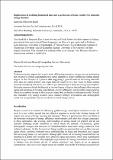Files in this item
Implications of declining household sizes and expectations of home comfort for domestic energy demand
Item metadata
| dc.contributor.author | Ellsworth-Krebs, Katherine | |
| dc.date.accessioned | 2020-06-15T23:34:43Z | |
| dc.date.available | 2020-06-15T23:34:43Z | |
| dc.date.issued | 2020-01 | |
| dc.identifier | 264659256 | |
| dc.identifier | 42aac28a-14bb-44f1-afc5-9181ba75397d | |
| dc.identifier | 85076931123 | |
| dc.identifier.citation | Ellsworth-Krebs , K 2020 , ' Implications of declining household sizes and expectations of home comfort for domestic energy demand ' , Nature Energy , vol. 5 , no. 1 , pp. 20-25 . https://doi.org/10.1038/s41560-019-0512-1 | en |
| dc.identifier.issn | 2058-7546 | |
| dc.identifier.other | RIS: urn:65B1FA5152803CBA2624DEF20C74A271 | |
| dc.identifier.other | RIS: Ellsworth-Krebs2019 | |
| dc.identifier.other | ORCID: /0000-0003-3098-1498/work/66398400 | |
| dc.identifier.uri | https://hdl.handle.net/10023/20087 | |
| dc.description | This research was made possible by a Carnegie Trust Research Incentive Grant (Grant no. RIG007515). | en |
| dc.description.abstract | Techno-economic approaches largely avoid delineating necessary energy uses or questioning how excessive lifestyle expectations may curtail attempts to achieve ambitious climate change targets. In this Perspective, I present data suggesting a general trend of increasing domestic floor area per capita globally and argue that this ought to be a key focus in future energy research, considering that house size is the largest determinant of domestic energy consumption. Particular attention should be directed at the confluence of factors that influence floor area per capita and questions of lifestyle expectations, energy sufficiency and invisible energy policies that have enabled the rise in floor area per capita both deliberately and inadvertently. Overall, this elucidates why energy research must consider lifestyle expectations and demographic trends that are generally seen as outside the remit of energy policy. | |
| dc.format.extent | 363427 | |
| dc.language.iso | eng | |
| dc.relation.ispartof | Nature Energy | en |
| dc.subject | G Geography (General) | en |
| dc.subject | HM Sociology | en |
| dc.subject | 3rd-DAS | en |
| dc.subject | SDG 7 - Affordable and Clean Energy | en |
| dc.subject | SDG 13 - Climate Action | en |
| dc.subject.lcc | G1 | en |
| dc.subject.lcc | HM | en |
| dc.title | Implications of declining household sizes and expectations of home comfort for domestic energy demand | en |
| dc.type | Journal article | en |
| dc.contributor.sponsor | Carnegie Trust | en |
| dc.contributor.institution | University of St Andrews. School of Geography & Sustainable Development | en |
| dc.identifier.doi | https://doi.org/10.1038/s41560-019-0512-1 | |
| dc.description.status | Peer reviewed | en |
| dc.date.embargoedUntil | 2020-06-16 | |
| dc.identifier.grantnumber | RIG007515 | en |
This item appears in the following Collection(s)
Items in the St Andrews Research Repository are protected by copyright, with all rights reserved, unless otherwise indicated.

